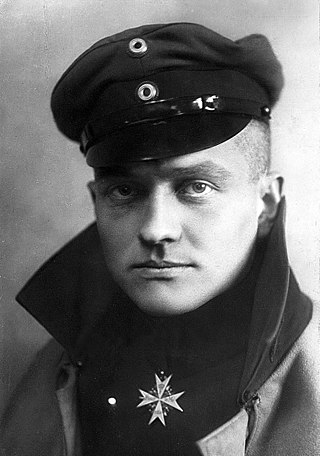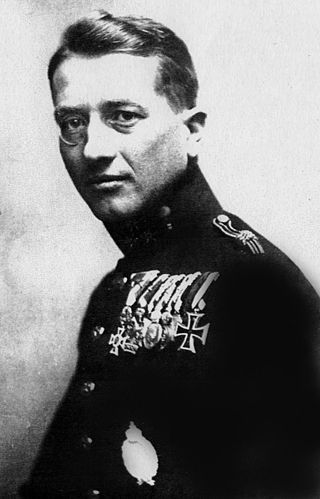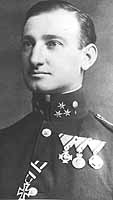
The Royal Flying Corps (RFC) was the air arm of the British Army before and during the First World War until it merged with the Royal Naval Air Service on 1 April 1918 to form the Royal Air Force. During the early part of the war, the RFC supported the British Army by artillery co-operation and photographic reconnaissance. This work gradually led RFC pilots into aerial battles with German pilots and later in the war included the strafing of enemy infantry and emplacements, the bombing of German military airfields and later the strategic bombing of German industrial and transport facilities.

World War I was the first major conflict involving the large-scale use of aircraft. Tethered observation balloons had already been employed in several wars and would be used extensively for artillery spotting. Germany employed Zeppelins for reconnaissance over the North Sea and Baltic and also for strategic bombing raids over Britain and the Eastern Front.

Charles Eugène Jules Marie Nungesser was a French ace pilot and adventurer. Nungesser was a renowned ace in France, ranking third highest in the country with 43 air combat victories during World War I.

Alfred Machin was a French actor and film director. He is remembered to have been one of the few French film directors whose films expressed progressive tendencies before World War I. He was also a pioneer of aerial filming. After 1920 Alfred Machin devoted himself to films of animals.

The following are lists of World War I flying aces. Historically, a flying ace was defined as a military aviator credited with shooting down five or more enemy aircraft during aerial combat. The term was first used by French newspapers, describing Adolphe Pégoud as l'as, after he downed seven German aircraft.

Godwin Karol Marian von Brumowsky was the most successful fighter ace of the Austro-Hungarian Air Force during World War I. He was officially credited with 35 air victories, with 8 others unconfirmed because they fell behind Allied lines. Just before the war ended, von Brumowski rose to command of all his country's fighter aviation fighting Italy on the Isonzo front.
CapitanoGuido Masiero was a World War I flying ace credited with five confirmed and ten unconfirmed aerial victories. He was a prewar lancer who used his civilian engineering expertise to wrangle a transfer to aviation duty.
Sous LieutenantConstant Emmanuel Plessis was a French World War I flying ace credited with five aerial victories.
Pierre Desire Augustin Ducornet was a French World War I flying ace credited with seven aerial victories, five of which were over enemy balloons, the two others were against enemy planes. He would continue active military service until 1933; he was recalled to active duty for World War II. He spent some time as an irregular in the French Resistance before returning to regular service. After the fighting was over, he continued to serve until May 1955.

Captain-Commandant Fernand Maximillian Leon Jacquet was a World War I flying ace credited with seven aerial victories. He was the first Belgian pilot to score an aerial victory, on 17 April 1915, and became the first Belgian ace on 1 February 1917. He was also the first Belgian pilot to fly the Belgian king Albert I to the front, in 1917. Additionally, he was the only Belgian honored by the British with a Distinguished Flying Cross.
Adjutant-Chef Antoine Laplasse was a World War I balloon buster and flying ace credited with eight aerial victories, six of which were against observation balloons.

Lieutenant Jean Chaput was a French World War I flying ace credited with 16 aerial victories.
Sous Lieutenant Jean Pie Hyacinthe Paul Jerome Casale, was a French World War I flying ace credited with thirteen aerial victories. He was one of the few aces that survived the entire course of fighter aviation in the war.

Adjutant Maxime Albert Lenoir was a pioneering World War I flying ace credited with eleven confirmed aerial victories, as well as eight unconfirmed.

Hauptmann Otto Jindra was an Austro-Hungarian flying ace during World War I, credited with nine aerial victories while flying as an aerial observer. His abilities as both leader and administrator led to his accelerated promotion and appointments to command of aviation units despite his lack of pilot's credentials. After World War I and Austria-Hungary both ended, Jindra became a major mover in founding a Czechoslovakian air arm, which he eventually rose to command.
Major Adrien Louis Jacques Leps was a French World War I flying ace credited with twelve confirmed aerial victories, as well as two probables. He served originally in the cavalry, before shifting to flying. In later years, he served under General Armand Pinsard during World War II.
Adjutant Armond/Armand Jean Berthelot (1894–1961) was a French World War I flying ace credited with eleven confirmed aerial victories. He was a scourge to enemy aerial observers, as his victory record contained six observation aircraft and two observation balloons.

During World War I, the national air services involved developed their own methods of assessing and assigning credit for aerial victories.
Aerial reconnaissance using heavier-than-air machines was an entirely new science that had to be improvised step-by-step. Early operations were low-level flights with the pilot often dismounting from the plane to report verbally to the nearest officers. Photographic support was urgently developed, initially requiring a full-time photographer on board to handle the heavy, awkward equipment. The interpreting of aerial images was an important new speciality, essential for accurate mapping. By 1915, air-to-ground radio was in use for reconnaissance pilots.












